This is the twentieth post in a series about my possible line of descent from Eleanor of Aquitaine. In the first post, I explained how I discovered the possible line, and how I am going to verify it one generation at a time. In the last post, I proved that my fifteenth great-grandmother Johanna van Wijfliet was the daughter of Willem van Wijfliet and Jenneken Henrick Daniels.
Willem van Wijfliet, son of Jan van Wijfliet
Research into Johanna van Wijfliet turned up several records that mentioned her father Willem:
- Court records and a list of brotherhood entry payments mentioned Willem as the husband of Jenneken, daughter of Henrick Danels and his wife Elisabeth/Lijsbeth.
- An anniversary book from the Tilburg church showed that Willem van Wijfliet and his wife Johanna payed money to have masses said for them.
These and other records will be analyzed for evidence about Willem’s parents.
Illustrous Dear Lady Brotherhood
Janna, Willem’s wife van Wijflet, with her mother Lijsbeth, wife of Henric Danels son, paid entry fees to become lay members of the Illustrous Dear Lady Brotherhood in ‘s-Hertogenbosch in 1440-1441.1 See the previous post for a description of the Brotherhood. Willem himself became a member in 1447-1448.2

Entry for entrance fees of Lijsbet, wife of Henrick Danels and her daughter Janna, wife of Willem van Wijflet
Entry for entrance fees for Willem van Wijflet
The brotherhood charged death duties. The ledgers do not record the death duties for Willem’s wife Janna. The death duties for Willem van Wijflet were paid in 1488-1489.3 His duties are recorded in a list of death duties fallen in arrears, of deaths that occurred in the past years. This entry shows Willem died by 1489, probably several years earlier.
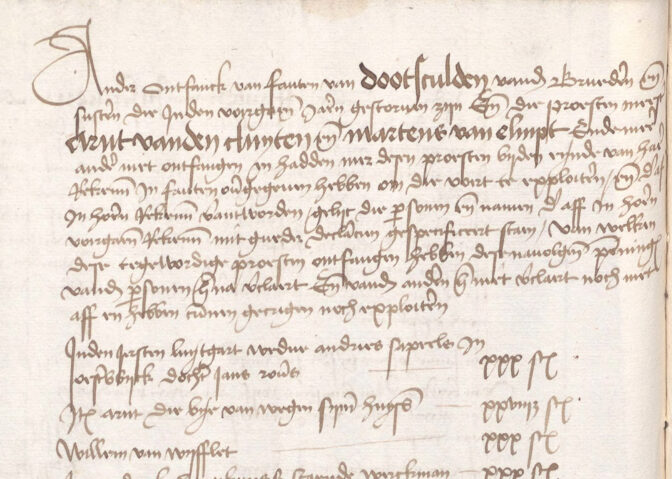
Entry for death duties of Willem van Wijfliet
Willem van Wijfliet and his brother-in-law
Willem van Wijfliet must have married Johanna, the daughter of Henrick Danels, prior to 28 October 1437, when he was mentioned in Den Bosch court records as the brother-in-law of Peter, son of Henrick Danels.4
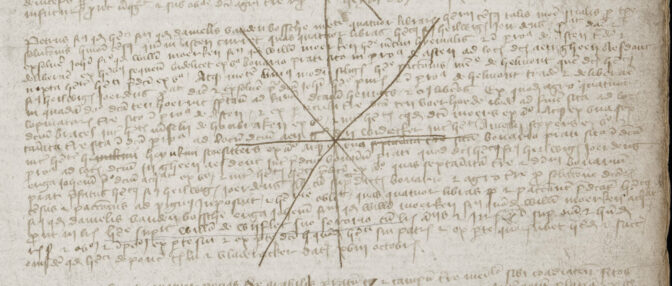
28 October 1437 court record
Tilburg anniversary book
An anniversary book of the church of Tilburg shows that Willem van Wijfliet and his wife Johanna paid to have masses said for them.5 Their choice of the Tilburg church suggests they lived there.
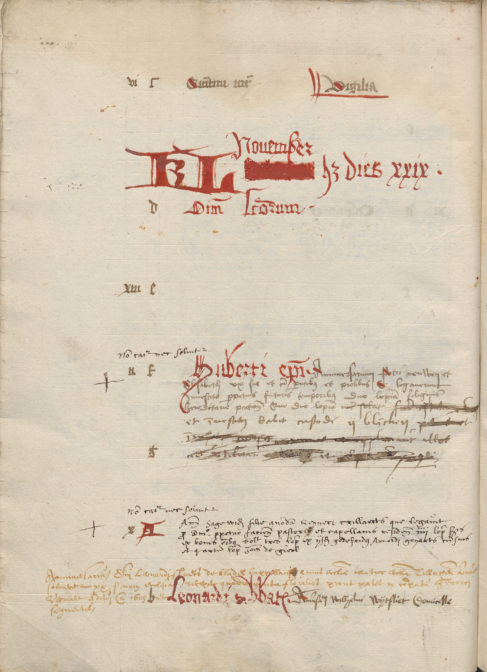
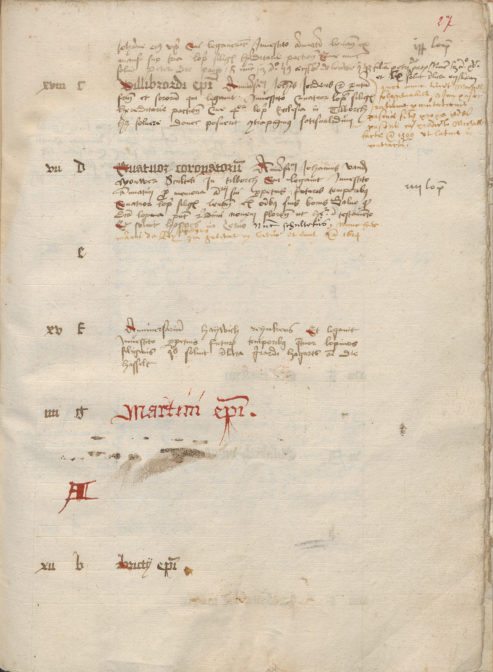
Anniversary book
Tilburg property
The court records of Den Bosch have dozens of entries mentioning a Willem van Wijfliet.6 They fall into two categories:
- Records for a Willem, son of Jan van Wijfliet. None of these mention a spouse or children.
- Records for a Willem van Wijfliet, husband of Johanna Henrick Daneels, father of Jan and Johanna. None of these records name Willem’s parents.
Property ownership in Tilburg links the two identities, proving both categories of records are for the same person.
In November 1427, Willem van Wijflet, son of the late Jan van Wijflet, rented the manor Steenveken in the parish of Tilburg to Jan Hubrecht Piggen.7 The record is damaged in one corner of the text, but the name of the owner and the property is in the undamaged part.
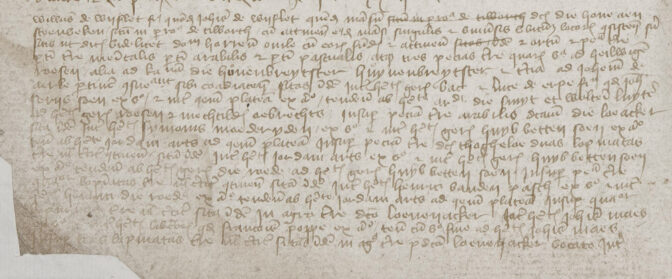
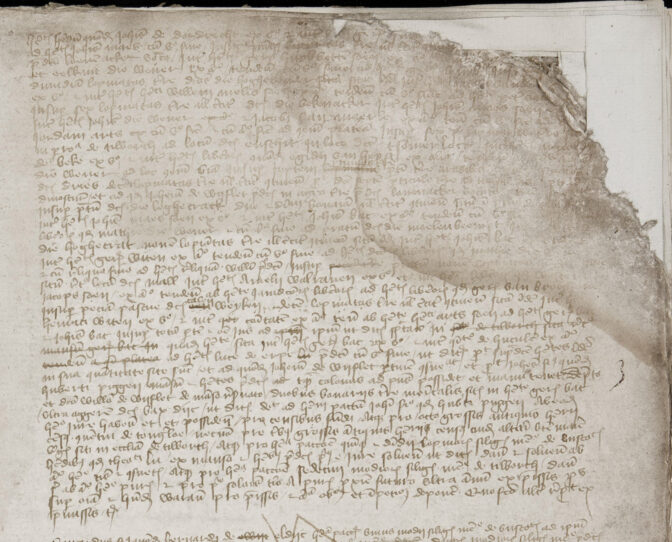
November 1427 rental agreement
On 12 May 1451, Willem van Wijfliet came to an agreement with his brother Jan. On that date, Jan van Wijflet, son of the late Jan van Wijflet, transported the following properties in the parish of Tilburg to his brother Willem:
- The Pluzenbeemdeken
- The Vrouwenbeempt at the Baxdijc [Bac’s dike], at the Leij [river]
- A field of one “buunder” [measure] called the Reijtbloc at the Baxdijc
- A rent of 7 “lopen” [measure] of rye from a manor at Steenveken.
In return, Willem gave up his claims on the feudal estates of their father in favor of his brother Jan.8
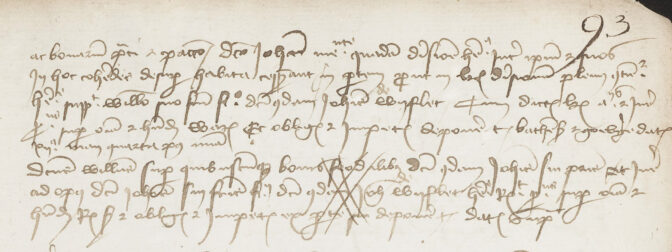
12 May 1451 transfer
Willem, son of the late Jan van Wijfliet, still owned the Steenveken manor on 23 April 1457.9

23 April 1457 court record
A court record from Den Bosch of 27 July 1461 names Wijllelmus de Wijflet [Willem van Wijfliet] and his wife Johanne, daughter of Henrick Danels with their son-in-law Willem Pijliser, son of the late lord Jan Pijliser, knight, husband of lady Jenneke. In this record, Willem transports half of the Steenveken manor to his daughter Jenneke.10
The ownership of the Steenveken manor proves that the Willem, son of the late Jan van Wijfliet, who owned the manor in 1427 and 1451 was the same person as WIllem van Wijfliet who owned the manor in 1461 when he transported half to his daughter.
The Vrouwenbeempt, one of the properties received by Willem van Wijfliet in 1451, was owned by Hendrick Willems Pijlijser in 1486.11 Hendricks Willems Pijlijser was the grandson of Willem Wijfliet, the son of his daughter Johanna van Wijfliet and Willem Pijlijser.12 Hendrick Willems Pijlijser must have inherited the property from his mother or grandfather. The ownership of the Vrouwenbeempt provides another link between Willem van Wijfliet, son of Jan, and the father of Johanna van Wijfliet, wife of Willem Pijlijser.

26 March 1486 ownership of the Vrouwenbeempt by Hendrick Willems Pijlijser
Feudal registers
The 1451 agreement stated that Willem gave up the claims in his father’s feudal estates to his brother Jan. Feudal registers of Brabant confirm that his brother and father held a fief from the Duke of Brabant.
In the feudal register of 1440-1465, called the Edaboek, Jan van Wijflet son of Jan was recorded as the holder of the manor Kerchove in Oisterwijck, that used to belong to Jan van Wijflet son of Jan Bacx van Tijlborch.13

Entry for Kerchoven in Edaboek, about 1440-1465
Kinship claim by Willem van Wijfliet
A record from 1428 confirms the family ties with Oisterwijk. On 16 November 1428, Johannes van Dussen sold a rent from the Zwanenborg manor in Oisterwijk, which his wife’s father Johannes van Dordrecht had acquired from Johannes van Wijfliet. Two days later, Willem van Wijfliet claimed the right of kinship and purchased the property. He transported 5/6th to the sons and sons-in-law of the late Johannes van Wijfliet:
- Johannes, son of Johannes van Wijfliet
- Berthout, son of Johannes van Wijfliet
- Johannes van Gerwen
- Johannes Adams die Lu
- Willem van Dinther.14
This implies that Willem kept the remaining 1/6th to himself, an equal share to the others, which is indirect evidence that he was a son of Johannes van Wijfliet too. Johannes is the Latin form of Jan.
The 1390-1394 register of the Den Bosch court records the original sale, whereby Johannes van Wijfliet sold a rent of 10 guilders from the Zwanenburg in the parish of Oisterwijk to Johannes van Dordrecht.15 The exact date is unclear.

Original sale of the rent between 1390 and 1394
Misdeed against Elsbeen Jans van Wijflit
The Oisterwijk court recorded on 13 December 1423 that Gherijt Wijten, bastard son of Gherijt Wijten, had committed a misdeed against lady Elsbeen Jans van Wijflit. Gherijt Wijten promised to Willem Jans van Wijflit for himself and his brother Jan and their next of kin, to leave the lands of Brabant, as soon as Roelof van Haestrecht, Jan Back Berthouts and Jan van Erpe son of Jan Serijs, would order him to do so. He could not return unless Jan and Willem, sons of the late Jan van Wijflit, agreed. Gherijt Wijten promised to fulfill any orders given to him by the arbiters Roelof van Haestrecht, Jan Back, and Jan van Erpe.
The brothers Gherit Wijten and Henric Wijten, sons of the late Gherijt Wijten, on behalf of Gherijt Wijten bastard of the said Gherijt Wijten, promised to hold Gherijt to his word. If Gherijt broke his word, his brothers would compensate. Gherijt and Henric Wijten, sons of the late Gherijt Wijten, and their nephews Gherijt and Marcelijs, sons of the late Wijtman Gherijt, promised to give Phijlijps van Meeghem 200 gold crowns.16
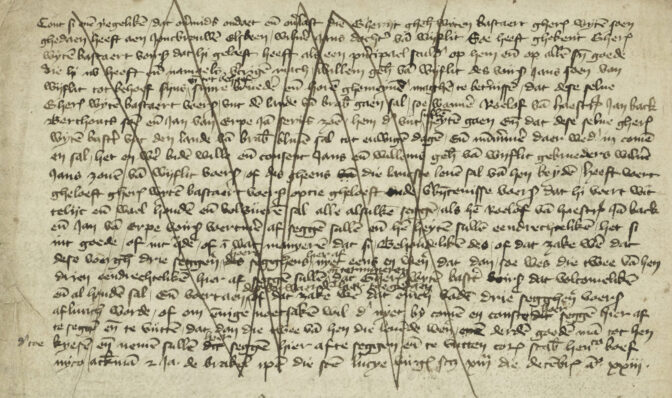
13 December 1423 agreement
To understand what is going on in this record, we have to understand the way the law worked in the Middle Ages. In this period, crimes against persons were mainly considered a personal affair, to be handled between the offending party and injured party. Reconciliation was the standard way to deal with this situations, with monetary compensation paid to the victim’s family in accordance with the station of the injured person. By the late Middle Ages, the government got involved and courts could prosecute crimes against people as well.17
This agreement takes place in 1423, in the transitional period between personal agreements and public prosecutions of crimes against persons. Apparently, Gherit, the bastard son of Gherijt Wijten, had committed a crime against lady Elsbeen, daughter of Jan van Wijfliet. The crime is described as an “ondaad” [literally: undeed, a misdeed]; probably a euphemism for rape. This event would seriously hurt Elsbeen’s value in the marriage market. It would be in Gherijt’s best interest to come to a personal agreement with Elsbeen’s family to avoid being prosecuted and possibly executed by the courts. Showing remorse and making amends could go a long way.
The agreement consisted of two parts: Gherijt would follow orders from the arbiters, physically removing himself from Brabant if they so ordered, and a sum of money was paid. 200 gold crowns was a great sum of money, befitting Elsbeen’s station as a lady. This money was not paid to the family, but to Philips van Meeghem. At this point it is unclear what his role was, or if he was any relation to Elsbeen. Three arbiters were appointed. This typically would be one person from each side, who between them picked a third person.
This record names Willem van Wijfliet with two of his siblings, brother Jan and sister Elsbeen, and names their father as the late Jan van Wijfliet. It is likely that at least one of the arbiters was kin too. Elsbeen later married Willem van Dinther.18 He was recorded as the son-in-law of Jan van Wijfliet in the 1428 kinship claim. The family relationships in the 1423 agreement over the misdeed against Elsbeen are consistent with those in the 1428 kinship claim.
Mother of Willem van Wijfliet
Records mentioning the wife of Jan van Wijfliet will be discussed in the next post. It is not certain whether his wife was the mother of Willem and his other known siblings. Since the line of descent from Eleanor of Aquitaine is through Jan van Wijfliet, the identity of Willem van Wijfliet’s mother is not necessary to prove the line.
Conclusion
Direct and indirect evidence from a range of sources leads to one conclusion: Willem van Wijfliet was the son of Jan van Wijfliet.
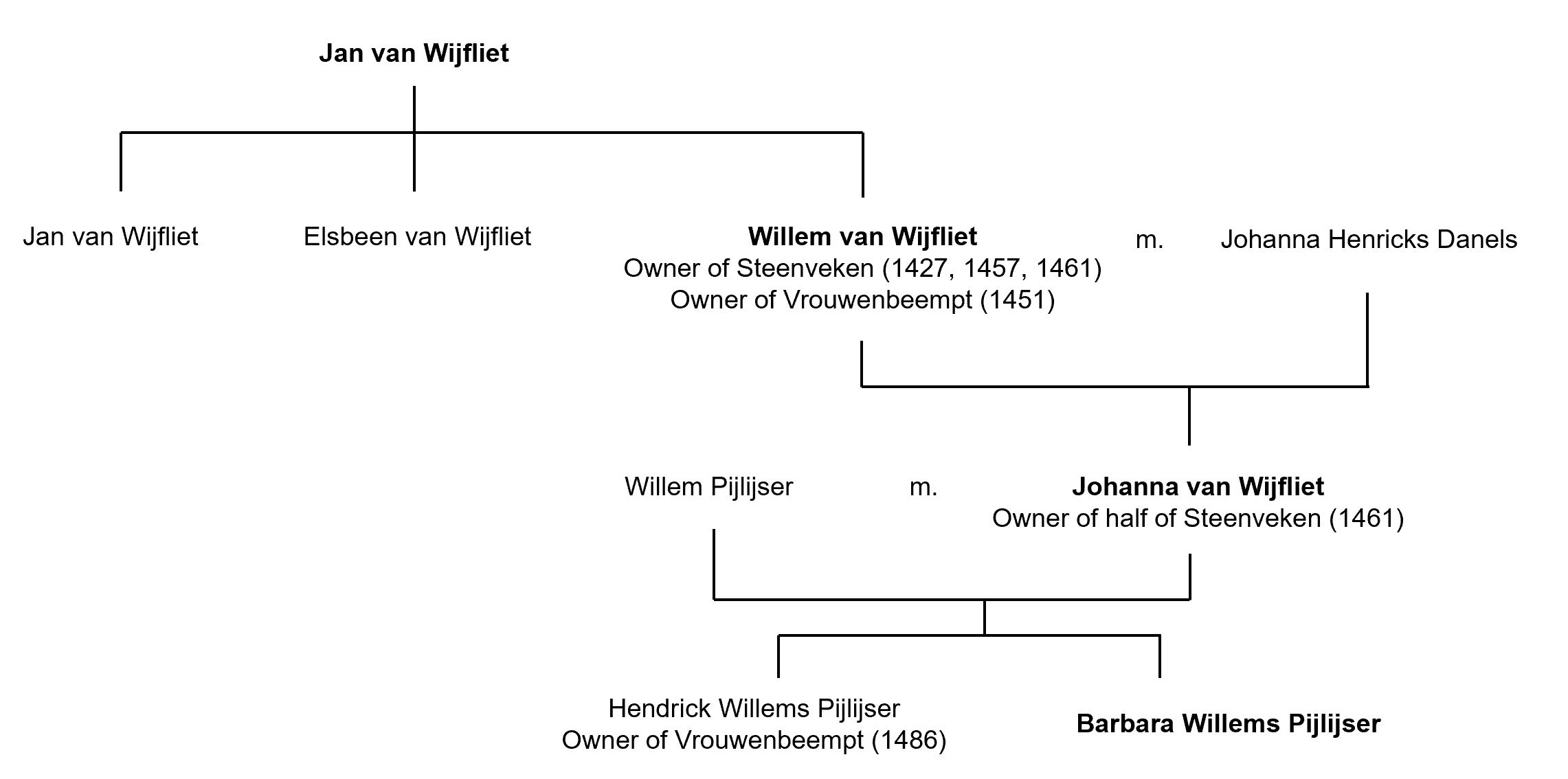
Relationships in this article. Possible line of descent of Eleanore of Aquitaine in bold.
The Tilburg anniversary books showed that Willem van Wijfliet and his wife Johanna had a personal connection to Tilburg, to choose that church to say masses for them. Court records showed they owned property there. Willem van Wijfliet, the husband of Johanna Henrick Danels owned the Steenveken manor in Tilburg in 1461, when he gave half to his daughter Jenneken, wife of Willem Pijlijser. Records of 1427 and 1451 showed that the manor was then owned by Willem van Wijfliet, son of Jan. That Willem son of Jan also owned the Vrouwenbeempt in Tilburg, property later owned by Willem van Wijfliet and Johanna Henrick Danels’ grandson Hendrick Willem Pijlijser. The ownership of the two properties over a long period of time proves that Willem van Wijfliet, son of Jan, was the same person as the father of Johanna van Wijfliet, wife of Willem Pijlijser.
Willem van Wijfliet and his brother Jan were mentioned together in several records as the sons of the late Jan van Wijfliet. In 1451, they came to an agreement whereby Willem received the Tilburg property in return for giving up his rights into their father’s feudal estates. Feudal records confirmed that Jan took over Jan van Wijfliet’s fiefs. In 1428, Willem van Wijfliet used his right of kinship to purchase a rent sold by Jan van Wijfliet between 1390 and 1394. He transported 5/6th of the rent to the sons and sons-in-law of Jan van Wijfliet. His equal share implies he was a son of Jan van Wijfliet too. In 1423, he acted on behalf of his brother Jan and other kin in an agreement with Gherit Wijten who had done a misdeed [raped?] their sister Elsbeen. This agreement names him as the son of Jan van Wijfliet.
No records were found to suggest Willem van Wijfliet had another father. The combination of evidence proves that Willem van Wijfliet was the son of Jan van Wijfliet. This brings us back to the early 1400s and late 1300s.
That is nineteen generations down, nine to go! We’re now more than two thirds of the way back to Eleanor of Aquitaine.
Next up: Generation 20: Jan van Wijfliet.
Sources
- Illustrous Dear Lady Brotherhood, account book 1431-1448, fol. 117v, entry for Lijsbeth wife of Henrick Daniels and daughter Janna (1440-1441); call no. 118, Illustrous Dear Lady Brotherhood in ‘s-Hertogenbosch, Record Group 1232; Brabants Historisch Informatie Centrum (BHIC), Den Bosch; finding aid and images, Archieven.nl (http://www.archieven.nl : accessed 25 February 2019).
- Illustrous Dear Lady Brotherhood, account book 1431-1448, fol. 228r, Willem van Wijfliet (1447-1448).
- Illustrous Dear Lady Brotherhood, account book 1485-1495, fol. 124v, Willem van Wijfliet (1488-1489); call no. 122, record group 12, BHIC.
- Aldermen’s Court (‘s-Hertogenbosch), Bosch Protocol 1436-1437, fol. 7, Peter Henrick Daniels record (28 October 1436); call no. 1207, Aldermen’s court of Den Bosch, Record Group 14; Erfgoed ‘s-Hertogenbosch, Den Bosch ; imaged as “Bosch protocol 1367-1809,” Erfgoed ‘s-Hertogenbosch (https://denboschpubliek.hosting.deventit.net/zoeken.php : accessed 12 May 2019).
- Roman Catholic Church (Tilburg), Liber Anniversiorum, entry for 6 November; call no. 546, collection acquisitions of the provincial archives Noord-Brabant, Record Group 339; Brabants Historisch Informatie Centrum, Den Bosch; finding aid and images, Archieven.nl (http://www.archieven.nl : accessed 24 February 2019).
- Card catalog of Bossche Protocol, drawer 276, entries for Willem van Wijfliet; Erfgoed ‘s-Hertogenbosch, Den Bosch; PDF with scans provided by Erfgoed ‘s-Hertogenbosch.
- Aldermen’s Court (‘s-Hertogenbosch), Bosch Protocol 1427-1428, fol. 2v-3r, Wijflet rental agreement (November 1427); call no. 1198, Record Group 14, Erfgoed ‘s-Hertogenbosch. Water damage and structural damage to the top right corner of page 3 lost some words and obscured others. The identification of the parties and the Steenveken manor is in the undamaged parts.
- Aldermen’s Court (‘s-Hertogenbosch), Bosch Protocol 1450-1451, fol. 92v-93r, Wijflet transfer of properties (12 May 1451); call no. 1221, record group 14, Erfgoed ‘s-Hertogenbosch.
- Aldermen’s Court (‘s-Hertogenbosch), Bosch Protocol 1456-1457, fol. 232, Wijflet (23 April 1457); call no. 1226, record group 14, Erfgoed ‘s-Hertogenbosch.
- Aldermen’s Court (‘s-Hertogenbosch), Bosch Protocol 1460-1461, fol. 214, Wijflet (27 July 1461); call no. 1231, record group 14, Erfgoed ‘s-Hertogenbosch.
- Aldermen’s Court (‘s-Hertogenbosch), Bosch Protocol 1485-1486, fol. 245, Hendrick Willems Pijlijser to Van Gestel (26 March 1486); call no. 1255, record group 14, Erfgoed ‘s-Hertogenbosch.
- For a full explanation of the relationships, see generation 17 and generation 18. For Hendrick Pijlijser, son of Willem Pijlijser and Johanna van Wijfliet, see land titles of land in Baardwijk, charter 1212, Henrik Ynwijnszn claim to land of Jan Pijlijser (13 September 1473); call no. 136, convents Mariënkroon and Mariëndonk in Heusden, record group 239; Brabants Historisch Informatie Centrum; finding aid and images, Archieven.nl (http://www.archieven.nl : accessed 24 February 2019). For Johanna van Wijfliet, daughter of Willem Wijfliet, see Aldermen’s Court (‘s-Hertogenbosch), Bosch Protocol 1460-1461, fol. 214, Wijflet (27 July 1461); call no. 1231, record group 14, Erfgoed ‘s-Hertogenbosch.
- Feudal Office of Brabant, “Edaboek,” about 1440-1465, fol. 393v, Jan van Wijflet; photocopy in call no. 278, Shadow Archives 20th Century; Brabants Historisch Informatie Centrum, Den Bosch; citing Feudal Office of Brabant, National Archives, Brussels, Belgium.
- Aldermen’s Court (‘s-Hertogenbosch), Bosch Protocol 1428-1429, fol. 165v, Van Dussen transport (16 November 1428) and Wijfliet kinship claim (18 November 1428); call no. 1199, record group 14, Erfgoed ‘s-Hertogenbosch.
- Aldermen’s Court (‘s-Hertogenbosch), Bosch Protocol 1390-1394, fol. 97, Van Wijfliet to Van Dordrecht; call no. 1179, record group 14, Erfgoed ‘s-Hertogenbosch.
- Aldermen’s Court (Oisterwijk), general protocol 1425-1426 [according to catalog, actual register starts in 1423], fol. 14v, Wijten and Wijfliet agreement (13 December 1423); call no. 145, Aldermen’s court of Oisterwijk, Record Group 847; Regionaal Archief Tilburg, Tilburg; consulted as finding aid and images, Regionaal Archief Tilburg (https://www.regionaalarchieftilburg.nl/zoek-in-archieven/?/details/NL-TbRAT-847 : accessed 17 May 2019).
- Erik-Jan Broers, “Ter Leering ende Vermaeck,” part 1, lecture at the Brabants Historisch Informatie Centrum, Den Bosch, 2 March 2019. Slides available via “Moord en doodslag 2019 #1: Van Godsoordeel tot beulsinstructie,” Regionaal Archief Tilburg (https://www.regionaalarchieftilburg.nl/home/blog-detail/algemeen/2019/03/03/moord-en-doodslag-2019-1-van-godsoordeel-tot-beulsinstructie/ : published 3 March 2019).
- A.C.M. Kappelhof, compiler, “Het Archief van de Tafel van de H. Geest van Den Bosch: Regesten van Oorkonden” [Archive of the Table of the Holy Spirit of Den Bosch: Abstracts of Charters], vol. 11, nos. 1462-1469, PDF, revision 2017, abstract of charter 2476, transport of usufruct of property in Deurne (11 February 1462); consulted as supplement to finding aid 0392 in category 14 (welfare) of “Archievenoverzicht” [Overview of Archives], Erfgoed ‘s-Hertogenbosch (https://www.erfgoedshertogenbosch.nl : accessed 25 May 2019).
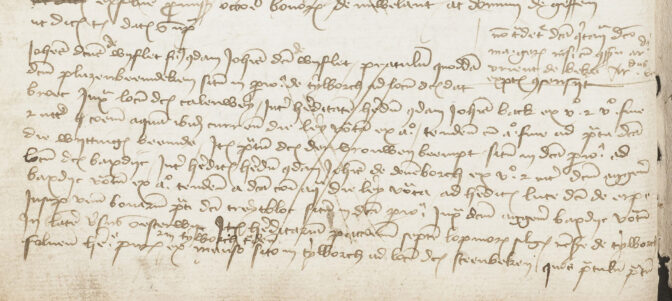



Yvette, this is such amazing research you have been doing. Thank you for sharing your journey!
Thanks for the compliment. It’s such a fun project to work on.
Yvette, what a wonderful job you have done, it surprises me every time which treasures you discover in the archives. How much has been preserved with the greatest care, the result of the work of clerks and curators.
How beautiful it is that you want to share this personal project, how grateful I am, you are in fact my legs and eyes, my health makes it impossible to visit the archives. Thank you very much for that
Hello Yvette.
If I can estimate correctly, you now come across a difficult link in the form of the Back family.
I hope it will work out, I wish you every success with this enormous challenge.
Kind regards, Angelique
Yes, you’re correct. What I started, I know the next link was though to be the most dubious one of the series. I’ve done a lot more research so we’ll have to wait and see. I haven’t finished so even I don’t know whether I’ll be able to prove the link.
Beste Yvette.
Even in het Nederlands, ik weet niet of je al bekend bent met deze heemkundekring.
Ik heb bij de Heemkundekring Nicolaus Poppelius uit Poppel, België, een aantal stukjes gevonden waarin de families Back en van Wijtvliet besproken worden.
Het gebied waarover het gaat is Poppel, Weelde en omgeving, hier hadden die families bezittingen en maalrechten op de molens.
Gijsbrecht Back huwde Catharina de Bie, vanaf 1351 was zij Vrouwe van Weelde, volgens de gegevens van van de heemkundekring waren ze de bewoners van een omwaterd slot, “de Borcht” een versterking die ook “Hof te Bergen” werd genoemd.
In de artikeltjes ook veel informatie over de nazaten die tot 1498 Heer van Weelde bleven.
Ook komt in een van de artikelen een bekende naam voor…. van Bruheze .. met de link naar Jan van Wijtvliet, natuurlijke zoon van Jan II van Brabant.
Google op Nicolaud Poppelius van Wijtvliet en er komen een paar linkjes tevoorschijn naar de PDF’s, zoals deze:
VII/. Enkele grepen uit de geschiedenis van Poppel, – Nicolaus Poppelius (specifiek pagina 44 t/m 47 en pagina 61 t/m 69 hoewel het de moeite loont om op Bac(k) en Wijtvliet te zoeken, er staat nog meer in)
https://www.yumpu.com/nl/document/view/10386800/weelde-toen-en-nu-heemkundekring-nicolaus-poppelius (hoofdstuk IV, deel 1 en 2 en ook even zoeken op Back en van Wijtvliet )
Er schijnen nog heel wat van Wijtvliets in Poppel te wonen, niet zo gek het ligt tegen de grens bij Tilburg aan, echt Back-van Wijtvliet gebied.
Hartelijke groet,
Angelique.
De link naar het eerste PDF . http://www.nicolaus-poppelius.be/Publicaties/Boeken/11.pdf
Daarin lees je op pagina 61 ook hoe Jan van Wijtvliet aan Kuijck en Grave kwam en dat geeft een heel andere kijk op het verhaal.